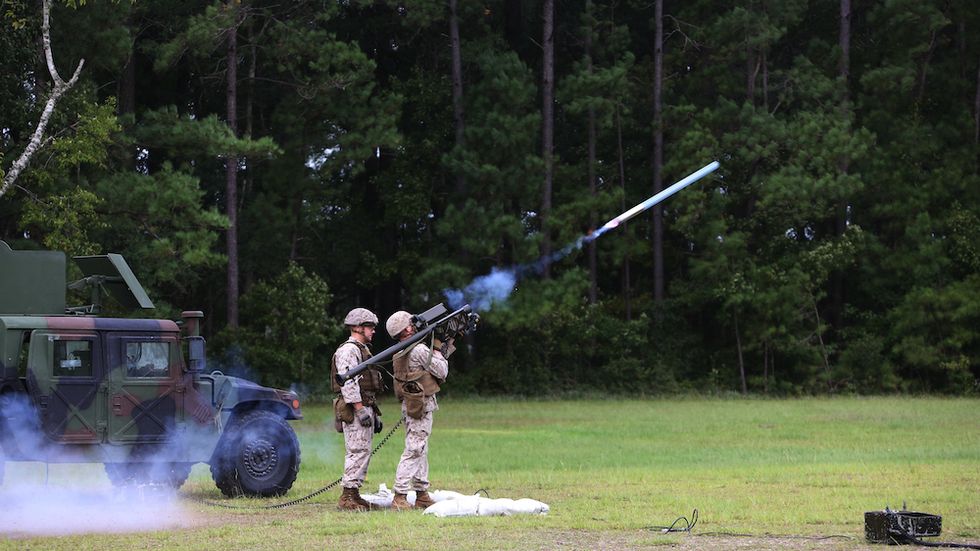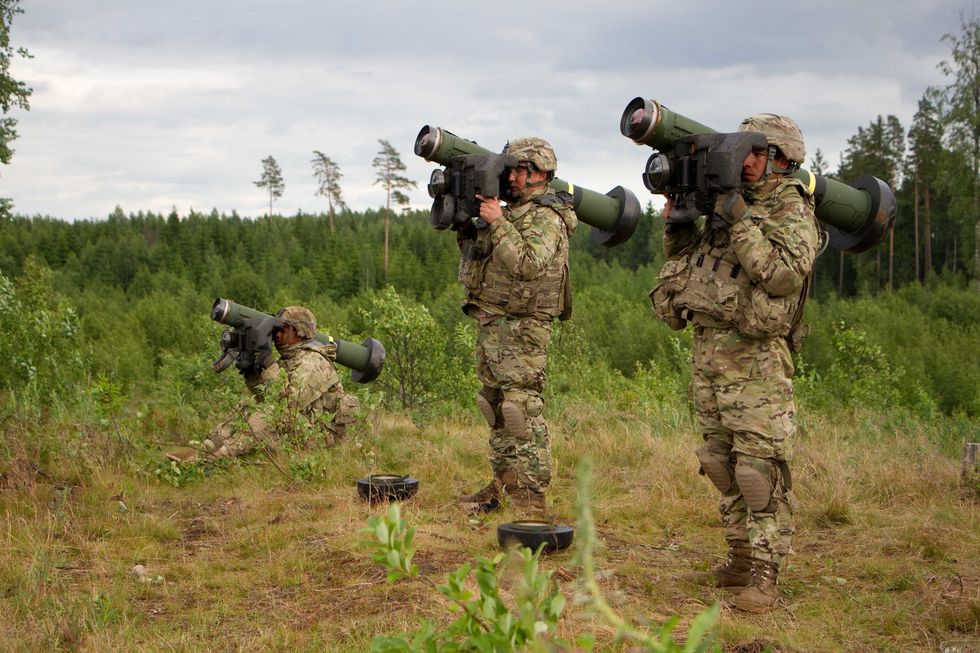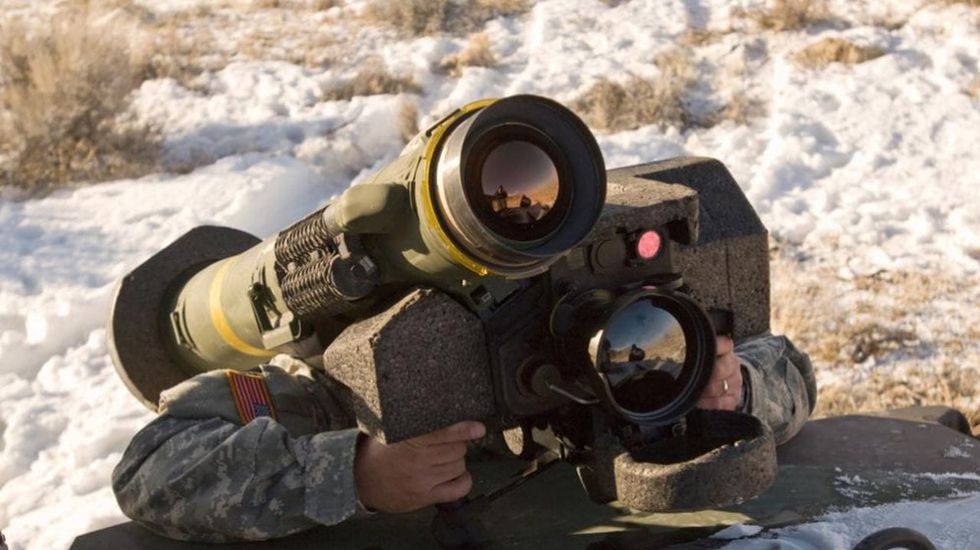- A new launcher for the Javelin missile is not only lighter and easier to use, but can also launch Stinger missiles.
- The redesigned Javelin Lightweight Command Launch Unit is smaller and more mobile, and can engage both ground and aerial targets.
- Although the design predates the war, it is seemingly made for a conflict like the invasion of Ukraine.
A new, improved launch unit for the Javelin missile can do more than just launch the now-famous anti-tank missile: it can also launch anti-air Stinger missiles. The new Lightweight Command Launch Unit is easier for soldiers to carry around, and can protect friendly airspace from aerial threats to boot. In a first this week, a Ukrainian shoulder-fired surface-to-air missile launcher shot down a Russian cruise missile, demonstrating the full spectrum of targets the new launch unit can engage, from tanks to cruise missiles.
A video of the shoot-down shows a Ukrainian air defense team, armed with an unknown man-portable air-defense system (MANPADS): either a Soviet-era SA-18 “Igla”, an American FIM-92 Stinger, or a Polish-made Piorun. A Russian cruise missile flies past the team, the turbine engine clearly audible. The MANPADS operator launches his missile, and seconds later, a distant explosion signals a successful intercept.
The eight-month-long war in Ukraine has reinforced many ideas about modern warfare, including the thought that sophisticated, relatively inexpensive missile systems, operated by a single person, can destroy multi-million-dollar weapons platforms like the T-90 tank, Ka-52 “Alligator” attack helicopter, Su-34 fighter bomber … and now cruise missiles. While these weapons have been around for years, Russia’s invasion of Ukraine has driven home the idea that a single missile operated by a single person can easily destroy weapons often touted as decisive. Ukrainian troops have single-handedly destroyed Russian tanks and armored vehicles with NLAW and Javelin anti-tank weapons, and Stinger missiles have shot down Russian aircraft and drones.
Battlefield drones have grown increasingly popular in recent years, serving in places like Libya, Nagorno-Karabakh, Ukraine, Israel, and elsewhere. The drones, cruising at relatively low altitudes, have been used for reconnaissance, surveillance, targeting, and dropping unguided munitions. Models such as the Iranian Shahed-136, which Russia bought by the planeload, are capable of one-way, kamikaze-style attacks.
Until now, the solution to the tank and armored vehicle threat was the Javelin missile; The solution to the aerial threat was the Stinger missile. Javelins are issued at a far greater rate in the U.S. Army, at two per platoon, or about one for every 20 soldiers. The growing threat from drones, however, is making previously neglected air defense systems more relevant than ever. Both Javelin and Stinger require command launch units (CLUs), which typically include a gripstock, sighting system, night-vision sight, controls, and indicators. The missile launch tube is attached to the CLU, the CLU is shouldered and switched on, and the soldier carrying it can engage multi-million-dollar targets with ease.
One solution? A single launcher that can fire both missiles. Raytheon, which makes both the Javelin and Stinger, is exhibiting the new Lightweight Command Launch Unit (LWCLU) at the Association of the U.S. Army show this week in Washington, D.C. Although the system was first tested in 2021, the war in Ukraine—especially recent events—makes it more relevant than ever.
The LWCLU was born out of an idea that the 1990s-era Javelin CLU could be made smaller and lighter due to advances in modern electronics and battery power. The original CLU weighed 14.16 pounds. Per National Defense, the new LWCLU is 30 percent smaller and 25 percent lighter. Overt Defense says it has a 50 percent increase in battery life, which is particularly useful with the Javelin, as the thermal imager is often used as a handy nighttime surveillance system. The defense site also says the LWCLU has an engagement range of 4,000 meters, or 2.48 miles, compared to the original CLU’s range of 2,500 meters, or 1.55 miles.
The Stinger/Lightweight CLU integration kit adds the Stinger missile plus a more useful and informative interface for the Stinger operator. Previously, an operator self-acquired the aerial threat, pointed a live Stinger at it, and a high-pitched aural tone would inform the operator the missile’s seeker had locked onto the aircraft. The new LWCLU displays the location and direction of an airborne threat provided by the Army’s air-defense battle network; It also displays a green, yellow, or red reticle to differentiate between a good lock, partial lock, or no lock at all.
This week’s MANPADS shootdown of a low-flying cruise missile makes LWCLU even more useful. Cruise missiles fly low and relatively slow to evade radar, thanks to their fuel-sipping turbine engines that prioritize range over speed. This makes them vulnerable to MANPADS, to which the cruise missile is just another low-flying aircraft—one that’s even easier to hit thanks to its lack of a pilot and the inability to take evasive action. A typical U.S. Army light infantry division includes 162 Javelin missile CLUs and 72 Stinger CLUs. The same division equipped with LWCLUs would have 162 Javelin CLUs and 234 Stinger-capable CLUs, a vast increase in low-level air defense capability.
The LWCLU won’t take the place of a dedicated area air defense system like the American Patriot, or the German IRIS-T just donated to Ukraine’s military. The short, two-mile range of a MANPADS weapon means defenders would need several LWCLUs to protect a town or even city from cruise missiles. Individual operators would need to stand watch with the 30-pound-plus weapon on their shoulders, and self-detect an incoming cruise missile. While it’s an imperfect capability, it’s nice to have in a pinch—especially when your adversary is striking civilian areas and even playgrounds.

Kyle Mizokami is a writer on defense and security issues and has been at Popular Mechanics since 2015. If it involves explosions or projectiles, he's generally in favor of it. Kyle’s articles have appeared at The Daily Beast, U.S. Naval Institute News, The Diplomat, Foreign Policy, Combat Aircraft Monthly, VICE News, and others. He lives in San Francisco.
















